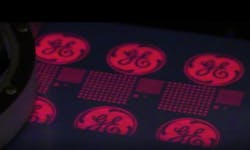In a keynote address at the virtual SID (Society for Information Display) Virtual Display Week Business Conference, GE presented an update on its narrowband phosphor technology that is sometimes referred to as line phosphors. The technology has been utilized both in LED-backlit liquid-crystal displays (LCDs) to deliver deeper red colors and in LED-based lighting to deliver both high-CRI warm CCTs and optimum efficacy. Now GE is working toward applying the technology to mini and micro LED displays through inkjet printing.
The PFS-KSF phosphor offer a very narrow emission band much like quantum dots. We first covered the technology back in 2015 when GE licensed the technology to both Sharp and Nichia, enabling those companies to manufacture LEDs using the phosphor, although the license only allowed the companies to sell the LEDs into display applications. Use of the line phosphor in general lighting was reserved for what was then GE Lighting and branded TriGain phosphor, prior to the launch of the Current business unit. Of course, Current (commercial lighting) and GE Lighting (consumer lighting) are now owned by other entities, but the now-GE Current still utilizes TriGain technology.
Back to the future, the display market has utilized the PFS-KSF technology in many LCD panels used in TV and computing applications. It was one of a number of technologies intended to boost red performance, which is not good in standard LCD TVs. Despite selling off its lighting businesses, GE has continued R&D on the phosphor technology. And at the conference, the company revealed a green line phosphor and its work applying the phosphor using inkjet technology (see photo).
The keynote at the business conference was presented by Dr. James Murphy, a GE researcher. Addressing legacy LED-backlit displays, he said, “We have experienced a color revolution in liquid-crystal displays over the past five years driven by narrowband phosphor innovation and developments. These latest breakthroughs will have GE well-positioned to drive that next color revolution for micro and mini LED displays.”
But what that quote from Murphy only implies is the company will also have deposition technology that can support mini and micro LED applications. We have covered the future of mini and micro LED technology several times and pledge more coverage going forward. A roadblock is how to handle the nanoscale LEDs. Most color display applications will require some new mass transfer process that can separately place large numbers of red, green, and blue emitters on a backplane forming the RGB pixels.
Another approach to displays would be through the use of monolithic wafer-scale technology — micro LED wafers that form larger portions of a display. But all the LEDs on such a wafer are blue, and the industry needs a way to make every second and third pixel in a line red and green. GE believes it can deliver on that concept with its inkjet printing of phosphor.
“GE’s Research Lab has been innovating in 3-D printing technologies, including direct write, or inkjet-printing technologies, for several decades,” said Murphy. “We tapped into the Lab’s deep experience with these 3-D, or additive processes, and came out with an exciting breakthrough that will pave the way for our narrowband red and green phosphors to be used in next generation micro and mini LED displays.”
Frankly, the SID address caught us off guard. We had assumed that the line phosphor technology went with Current in that divestiture (more on that in a moment). But a GE spokesperson said the company has continued to work on it within the technology licensing division that remains in GE.
We asked the spokesperson about a timeframe for commercial deployment of the printed phosphor technology. The company said sampling will happen in 2021 and it expects to have commercial viability in the same timeframe in which the display industry is planning micro LED commercial production. We would note that a breakthrough such as GE is suggesting could actually accelerate the realization of commercial micro LED displays.
We further asked GE about how tiny, or what minimum feature size in terms of line width, might be possible with the inkjet printing approach. Remember that micro LEDs are generally considered to measure less than 100 µm (microns or micrometers) per side. So an inkjet printer would essentially need to have even better accuracy and smaller feature size than that of the LED. The GE spokesperson said the current technology would support 20-µm feature sizes and that it is working on technologies to go smaller.
We also asked GE about the use of the PFS-KSF phosphor in general lighting. The spokesperson said they could not comment on the phosphor beyond the display application. GE Current, however, continues to promote TriGain on its website both for general lighting and even for horticultural lighting. We have a question into GE Current about who owns that intellectual property (IP) and will update this story if we learn more.
When last we heard about the line phosphor technology from GE in the spring of 2019, the company along with GE Current (already owned by AIP at the time) and GE Lighting had jointly filed suit against Cree for infringing phosphor patents. Subsequently, those companies settled that suit.
For up-to-the-minute LED and SSL updates, why not follow us on Twitter? You’ll find curated content and commentary, as well as information on industry events, webcasts, and surveys on our LinkedIn Company Page and our Facebook page.





